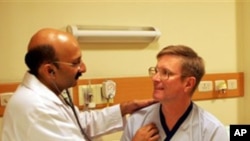Much has been reported about the rapidly expanding Asian economy. Perhaps one of the fastest growing aspects of many Asian economies is medical tourism, with India, South Korea and Thailand leading the way.
“Medical tourism is the travel of individuals from a home country like the U.S., Britain, even Singapore, Thailand in the region to a destination for the primary purpose of seeking medical care," said Glenn Cohen, the Co-director of the Petrie-Flom Center for Health Law Policy, Biotechnology and Bioethics at the Harvard University law school.
He said medical tourism comes in what he terms "three flavors".
“The first flavor ,especially in the U.S., is uninsured or underinsured individuals who are doing price shopping. By one estimate, getting angioplasty out of pocket in the United States would cost about $98,000. If you’re getting it in Thailand or Singapore you’re looking at $13,000. So huge cost saving is one aspect of looking for medical travel abroad. A second group of people are people who have insurance coverage that gives them an incentive to go abroad. We have a little bit of that in the U.S. And then a third category are individuals who are seeking to avoid domestic prohibition or unavailability of a service. For example, a lot of Irish engage in what could be called 'abortion tourism', [where] people travel to Switzerland for assisted suicide and people travel elsewhere for stem cell therapy and the like, and of course to India for surrogacy tourism and the like," he said.
Cohen says this has translated into big businesses around the world.
“Cuba in 2004 made about $20 million on medical tours and Jordan made about $500 million. It's estimated that by 2012, India will be looking at about $2.2 billion in revenue. This is a very fast growing industry and a number of countries are making a very concerted effort to corner at least the regional market. There is some division as to the kind of services they offer. But it’s a very lucrative industry and there are also all kinds of other players who we call intermediaries or facilitators who try to arrange travel for you and kind of act as concierges in some way in the industry," he said.
Asia is a particularly fast growing market for medical tourism. A recent report from the Indian market research company RNCOS predicts a growth rate of over 17.5 percent in Asia by next year.
Among the leaders in Asian medical tourism are India, South Korea and Thailand. China wants to be part of that group.
According to Dr. David Vequist, who heads the Center for Medical Tourism Research in San Antonio, Texas, they are doing just that.
"China is interested in developing a medical tourism specialty and in fact there are efforts going on in places like Shanghai in order to develop a medical hub. It would be similar to what the Koreans have done or the Japanese have done or Thailand, or some of these other countries that have been active in medical tourism, India, for example," he said.
According to Vequist, China, due to its huge population, may have an edge over other countries.
“China, as a country has quite a few people who travel within the country for health care and increasingly have people who travel outside the country for health care. The majority of the health care facilities inside the country don’t necessarily have a great global reputation for health care. Gallup recently released a study that shows that 15 percent of Chinese citizens are travelling within the country to find better health care. And what we’re finding is as Chinese tourism picks up around the world, we’re seeing more and more Chinese nationals going to other countries and receiving surgeries and pharmaceuticals and other types of health care outside of China," he said.
Vequist says a growing medical tourism reputation inside China might lead to those people seeking treatment in their own country.
While the expanding world of medical tourism is undoubtedly good for economies, there are some major concerns that need to be addressed.
Asia Cashing in on Medical Tourism
- By Ira Mellman





